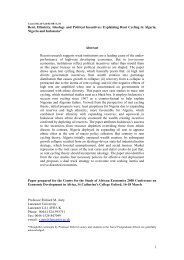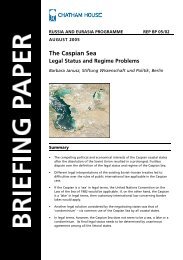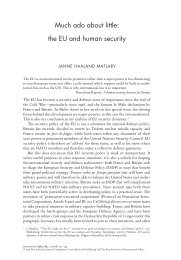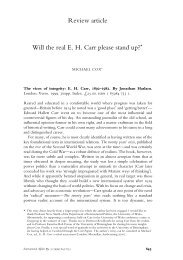The UK and European defence: leading or leaving? - Chatham House
The UK and European defence: leading or leaving? - Chatham House
The UK and European defence: leading or leaving? - Chatham House
You also want an ePaper? Increase the reach of your titles
YUMPU automatically turns print PDFs into web optimized ePapers that Google loves.
<strong>The</strong> <strong>UK</strong> <strong>and</strong> <strong>European</strong> <strong>defence</strong><br />
being met, of delay in launching an operation, <strong>and</strong> of incurring casualties <strong>and</strong> loss<br />
of equipment. True, ten years is a sh<strong>or</strong>t time to judge, because capability development<br />
is an inherently long-term process. But the question must be asked whether<br />
the mechanism will ever make the huge strides necessary to reach the goal. 7<br />
<strong>The</strong> main obstacle is the almost exclusively bottom-up nature of the process.<br />
Although the EDA is a key EU-level act<strong>or</strong>, national capitals are the drivers. During<br />
the <strong>European</strong> Convention (2001–2003) the intention, including in London, was to<br />
complement this indispensable bottom-up dynamic with top-down guidance <strong>and</strong><br />
co<strong>or</strong>dination. To this end a new mechanism, spons<strong>or</strong>ed by the <strong>UK</strong> <strong>and</strong> France, was<br />
included in the draft Constitutional Treaty adopted by the Convention: Permanent<br />
Structured Cooperation. That is also why the EDA, which was included in<br />
the draft treaty, was set up in 2004, bef<strong>or</strong>e its ratification. When the Constitutional<br />
Treaty <strong>and</strong> afterwards the Lisbon Treaty ran into difficulties, however, several<br />
member states swallowed their ambitions. <strong>The</strong> EDA was among the main casualties,<br />
as the <strong>UK</strong> in particular (consistently, given its resistance to common funding,<br />
but paradoxically, in view of its focus on capabilities) refused to countenance m<strong>or</strong>e<br />
than minimal budgetary <strong>and</strong> personnel provision. This made it very difficult f<strong>or</strong><br />
the EDA to perf<strong>or</strong>m its ambitious tasks.<br />
<strong>The</strong> EDA has made a valiant eff<strong>or</strong>t, proposing multinational solutions to address<br />
the pri<strong>or</strong>ity sh<strong>or</strong>tfalls <strong>and</strong> attempting to persuade member states to ab<strong>and</strong>on <strong>or</strong><br />
merge national projects. When members are willing to pool their eff<strong>or</strong>ts, in<br />
varying clusters acc<strong>or</strong>ding to the project, this approach yields imp<strong>or</strong>tant results.<br />
But in most cases capitals, including London, have not been willing to answer the<br />
call. Member states are not motivated to invest in a capability area simply because<br />
it has been identified as a pri<strong>or</strong>ity sh<strong>or</strong>tfall at EU level. Each looks to the others<br />
to make the first move, fearing to contribute too much of its own limited <strong>defence</strong><br />
budget to a collective programme as compared to the extent that it expects to have<br />
to draw on it. Meanwhile <strong>defence</strong> planning decisions continue to be taken in isolation,<br />
as a function of national requirements, without co<strong>or</strong>dination with fellow<br />
member states. As a result, redundant capabilities (representing overcapacity <strong>or</strong><br />
being non-deployable) are maintained while the strategic enablers are lacking. <strong>The</strong><br />
conclusion is that co<strong>or</strong>dination at tactical level, that is, on a project-by-project<br />
basis, is insufficient to achieve the ambitions of the ESDP.<br />
<strong>The</strong> <strong>UK</strong> was rightly disappointed with the lack of eff<strong>or</strong>t on the part of many<br />
other member states. Yet the British-fed perception of useless ESDP structures that<br />
duplicate NATO must be taken with a pinch of salt. Thanks to its broad scope<br />
<strong>and</strong> its proximity to its ‘customers’, the EDA has achieved m<strong>or</strong>e results than Allied<br />
Comm<strong>and</strong> Transf<strong>or</strong>mation, its US-based NATO counterpart, with barely a tenth<br />
of the staff. <strong>The</strong> problem is not so much too many structures as a lack of willingness<br />
to use <strong>or</strong> fund them as intended, in the case of the EDA notably by the <strong>UK</strong> itself. 8<br />
Through such delaying tactics, London has created the perception that it prevents<br />
7 Sven Biscop <strong>and</strong> Jo Coelmont, Europe, strategy <strong>and</strong> armed f<strong>or</strong>ces (London: Routledge, 2012), pp. 68–71.<br />
8 Clara Marina O’Donnell, ‘Britain’s coalition government <strong>and</strong> EU <strong>defence</strong> cooperation: undermining British<br />
interests’, International Affairs 87: 2, March 2011, pp. 419–33 at p. 424.<br />
International Affairs 88: 6, 2012<br />
Copyright © 2012 <strong>The</strong> Auth<strong>or</strong>(s). International Affairs © 2012 <strong>The</strong> Royal Institute of International Affairs.<br />
1303














